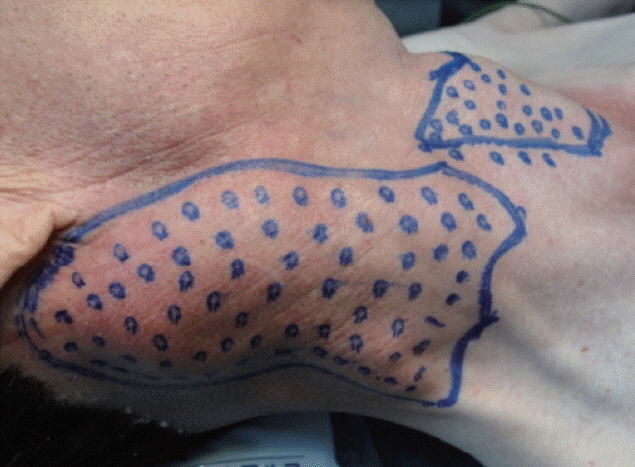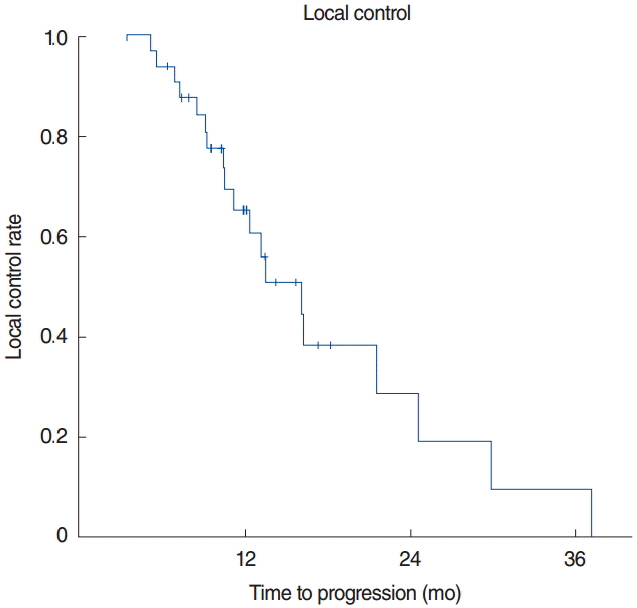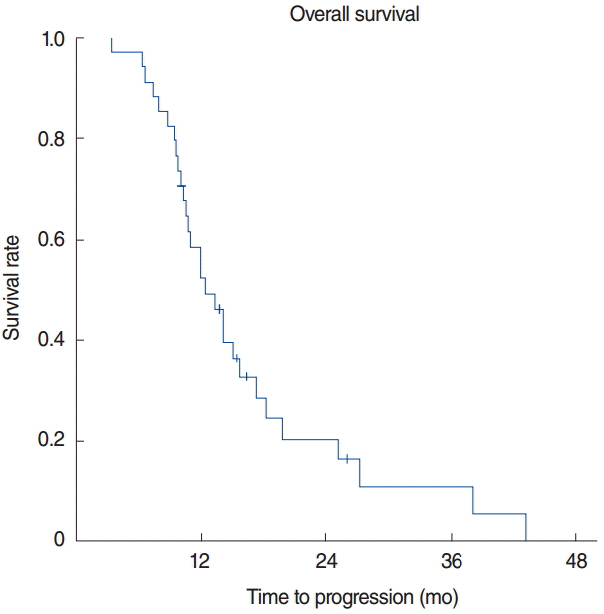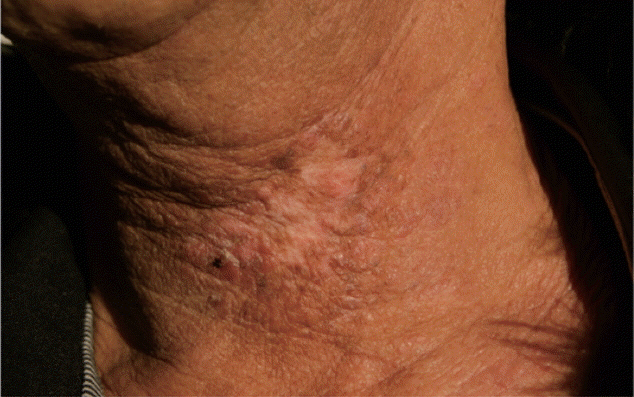Clin Exp Otorhinolaryngol.
2016 Sep;9(3):185-191. 10.21053/ceo.2015.00213.
¹²âµI Seed Permanent Implantation as a Palliative Treatment for Stage III and IV Hypopharyngeal Carcinoma
- Affiliations
-
- 1Head and Neck Tumor Research Center, No. 3 Affiliated Hospital of Kunming Medical University, Kunming, China. 761503929@qq.com
- 2Radiation Therapy Research Center, No. 3 Affiliated Hospital of Kunming Medical University, Kunming, China.
- 3Department of ENT, Kunming City Children's Hospital, Kunming, China.
- KMID: 2353614
- DOI: http://doi.org/10.21053/ceo.2015.00213
Abstract
OBJECTIVES
The aim of this study was to investigate the feasibility and safety of percutaneous ¹²âµI seed permanent implantation for advanced hypopharyngeal carcinoma from toxicity, tumor response, and short-term outcome.
METHODS
¹²âµI seeds implant procedures were performed under computed tomography for 34 patients with advanced hypopharyngeal carcinoma. We observed the local control rate, overall survival, and acute or late toxicity rate.
RESULTS
In the 34 patients (stage III, n=6; stage IV, n=28), the sites of origin were pyriform sinus (n=29) and postcricoid area (n=5). All patients also received one to four cycles of chemotherapy after seed implantation. The post-plan showed that the actuarial D90 of ¹²âµI seeds ranged from 90 to 158 Gy (median, 127 Gy). The mean follow-up was 12.3 months (range, 3.4 to 43.2 months). The local control was 2.1-31.0 months with a median of 17.7 months (95% confidence interval [CI], 13.4 to 22.0 months). The 1-, 2-, and 3-year local controls were 65.3%, 28.6%, and 9.5% respectively. Twelve patients (35%) died of local recurrence, fourteen patients (41%) died of distant metastases, and three patients (9%) died of recurrence and metastases at the same time. Five patients (15%) still survived to follow-up. At the time of analysis, the median survival time was 12.5 months (95% CI, 9.5 to 15.4 months). The 1-, 2-, and 3-year overall survival rates were 55.2%, 20.3%, and 10.9%, respectively. Five patients (15%) experienced grade 3 toxic events and nine patients (26%) have experienced grade 2 toxic events.
CONCLUSION
This review shows relatively low toxicity for interstitial ¹²âµI seed implantation in the patients with advanced stage hypopharyngeal cancer. The high local control results suggest that ¹²âµI seed brachytherapy implant as a salvage or palliative treatment for advanced hypopharyngeal carcinoma merit further investigation.
MeSH Terms
Figure
Reference
-
1. Godballe C, Jorgensen K, Hansen O, Bastholt L. Hypopharyngeal cancer: results of treatment based on radiation therapy and salvage surgery. Laryngoscope. 2002; May. 112(5):834–8.
Article2. MacKenzie RG, Franssen E, Balogh JM, Gilbert RW, Birt D, Davidson J. Comparing treatment outcomes of radiotherapy and surgery in locally advanced carcinoma of the larynx: a comparison limited to patients eligible for surgery. Int J Radiat Oncol Biol Phys. 2000; Apr. 47(1):65–71.
Article3. Chu PY, Li WY, Chang SY. Clinical and pathologic predictors of survival in patients with squamous cell carcinoma of the hypopharynx after surgical treatment. Ann Otol Rhinol Laryngol. 2008; Mar. 117(3):201–6.
Article4. Jiang YL, Meng N, Wang JJ, Jiang P, Yuan HSh, Liu C. CT-guided iodine-125 seed permanent implantation for recurrent head and neck cancers. Radiat Oncol. 2010; Jul. 5:68.
Article5. Krempien RC, Grehn C, Haag C, Straulino A, Hensley FW, Kotrikova B, et al. Feasibility report for retreatment of locally recurrent head-and-neck cancers by combined brachy-chemotherapy using frameless image-guided 3D interstitial brachytherapy. Brachytherapy. 2005. 4(2):p. 154–62.
Article6. Jiang YL, Meng N, Wang JJ, Ran WQ, Yuan HS, Qu A, et al. Percutaneous computed tomography/ultrasonography-guided permanent iodine-125 implantation as salvage therapy for recurrent squamous cell cancers of head and neck. Cancer Biol Ther. 2010; Jun. 9(12):959–66.
Article7. Wang JJ, Yuan HS, Li JN, Jiang WJ, Jiang YL, Tian SQ. Interstitial permanent implantation of 125I seeds as salvage therapy for re-recurrent rectal carcinoma. Int J Colorectal Dis. 2009; Apr. 24(4):391–9.
Article8. Lapeyre M, Belliere A, Hoffstetter S, Peiffert D. Brachytherapy for head and neck cancers (nasopharynx excluded). Cancer Radiother. 2008; Nov. 12(6-7):515–21.9. Urba SG, Moon J, Giri PG, Adelstein DJ, Hanna E, Yoo GH, et al. Organ preservation for advanced resectable cancer of the base of tongue and hypopharynx: a Southwest Oncology Group Trial. J Clin Oncol. 2005; Jan. 23(1):88–95.
Article10. Lefebvre JL, Rolland F, Tesselaar M, Bardet E, Leemans CR, Geoffrois L, et al. Phase 3 randomized trial on larynx preservation comparing sequential vs alternating chemotherapy and radiotherapy. J Natl Cancer Inst. 2009; Feb. 101(3):142–52.
Article11. Cmelak AJ, Li S, Goldwasser MA, Murphy B, Cannon M, Pinto H, et al. Phase II trial of chemoradiation for organ preservation in resectable stage III or IV squamous cell carcinomas of the larynx or oropharynx: results of Eastern Cooperative Oncology Group Study E2399. J Clin Oncol. 2007; Sep. 25(25):3971–7.
Article12. Liu WS, Hsin CH, Chou YH, Liu JT, Wu MF, Tseng SW, et al. Long-term results of intensity-modulated radiotherapy concomitant with chemotherapy for hypopharyngeal carcinoma aimed at laryngeal preservation. BMC Cancer. 2010; Mar. 10:102.
Article13. Vikram B, Hilaris BS, Anderson L, Strong EW. Permanent Iodine-125 implants in head and neck cancer. Cancer. 1983; Apr. 51(7):1310–4.
Article14. Obinata K, Ohmori K, Shirato H, Nakamura M. Experience of high-dose-rate brachytherapy for head and neck cancer treated by a customized intraoral mold technique. Radiat Med. 2007; May. 25(4):181–6. a.
Article
- Full Text Links
- Actions
-
Cited
- CITED
-
- Close
- Share
- Similar articles
-
- Results of Conventional Radiotherapy in Hypopharyngeal Cancer
- Long-Term Treatment Outcomes of Hypopharyngeal Cancer Using Different Surgical Modalities
- Endoscopic Resection of Hypopharyngeal Squamous Cell Carcinoma
- The Analysis of Induction Chemotherapy Using Docetaxel and Platinum in Treatment of Hypopharyngeal Carcinoma
- Treatment Results of Hypopharyngeal Carcinoma







